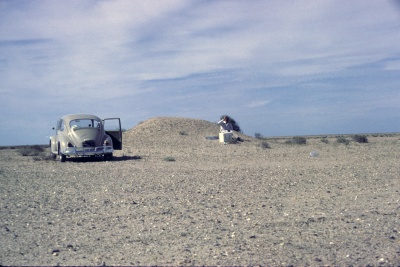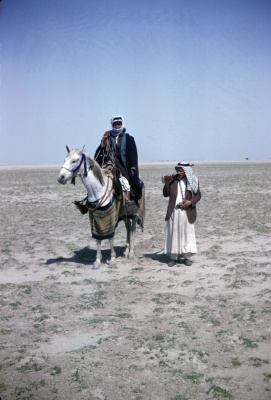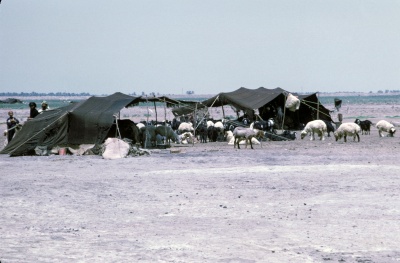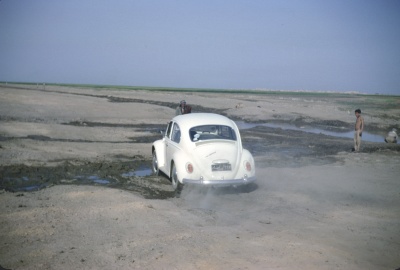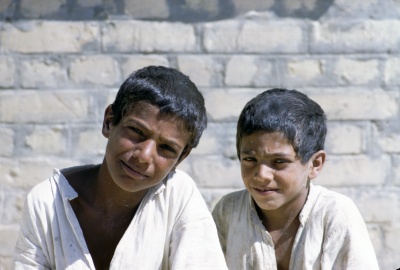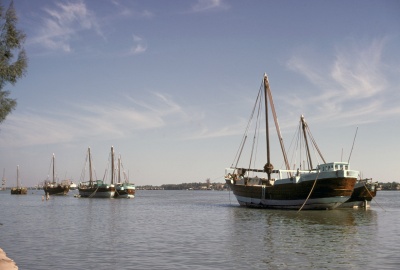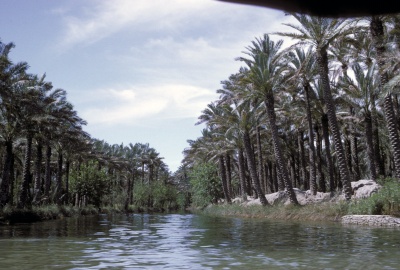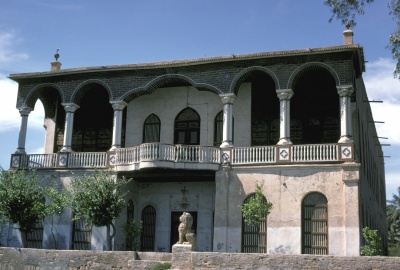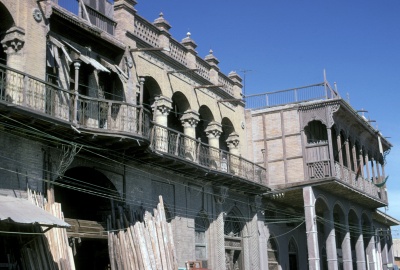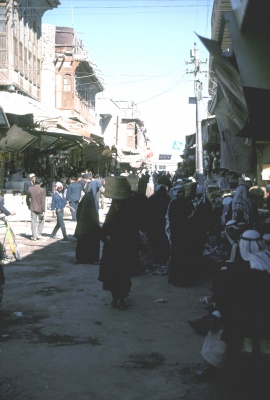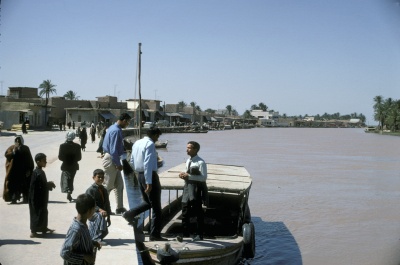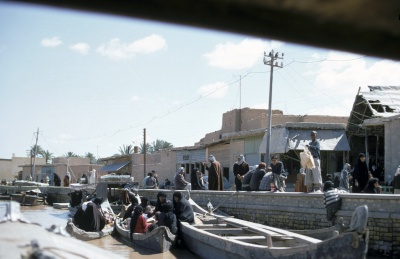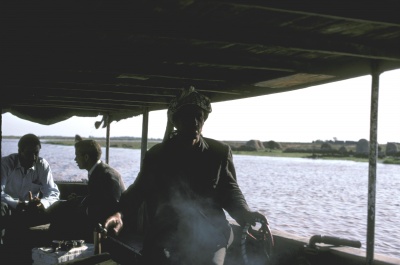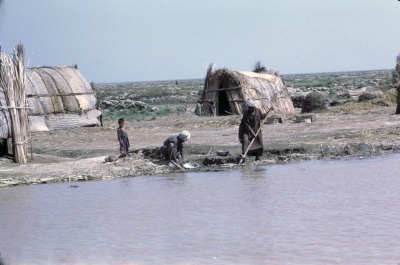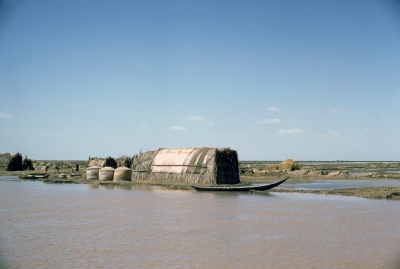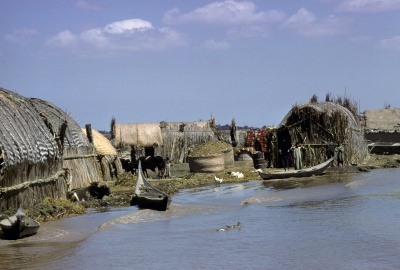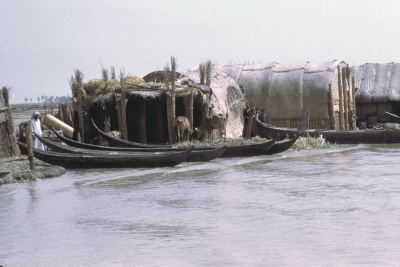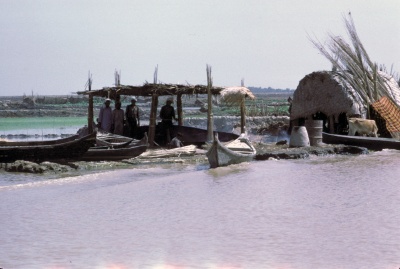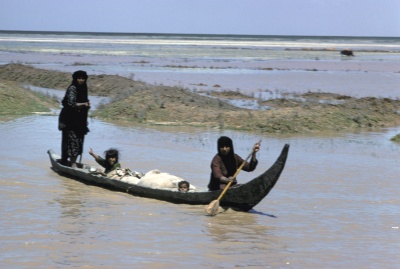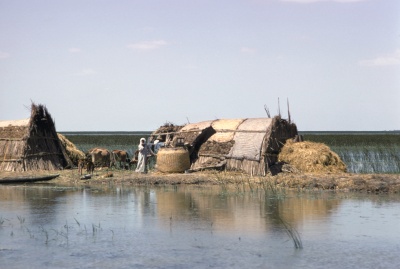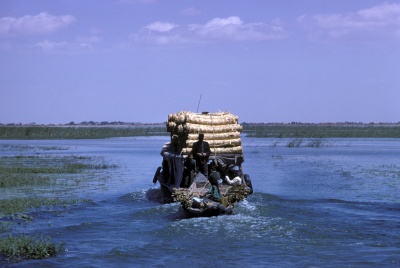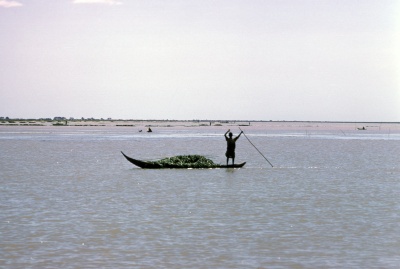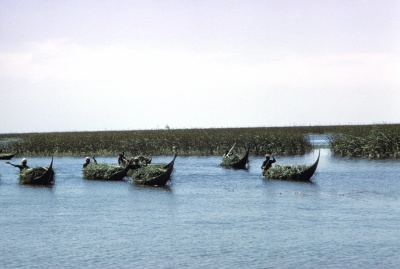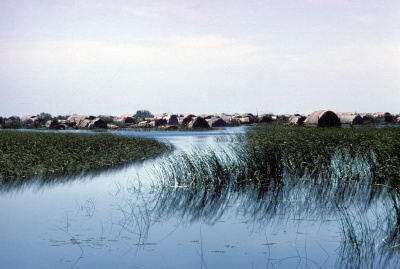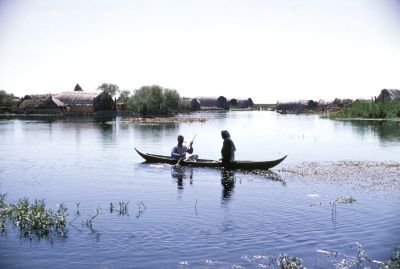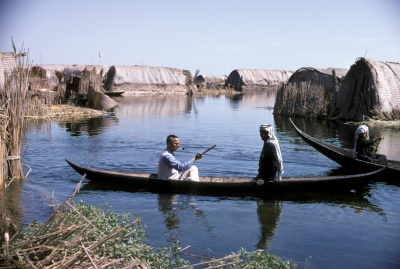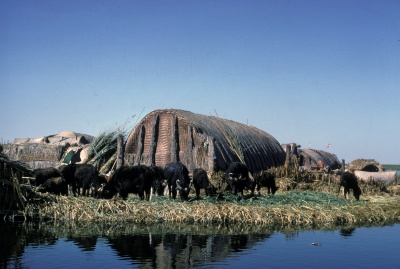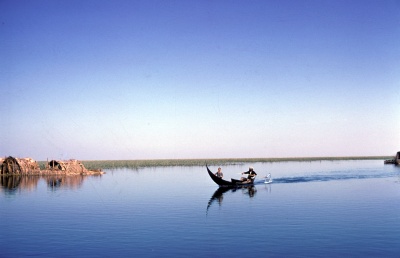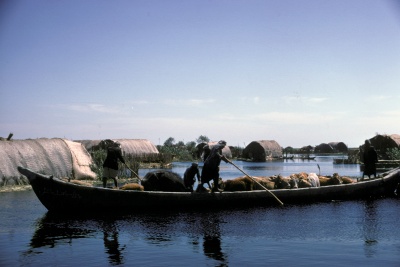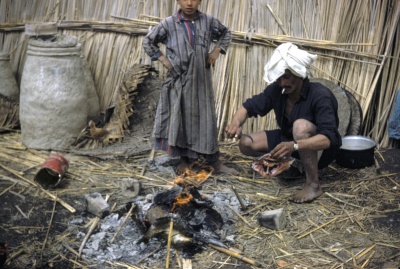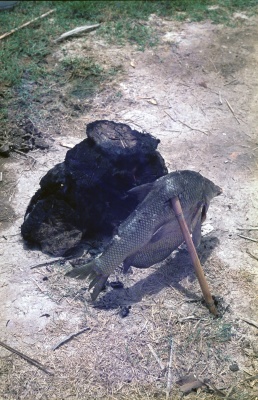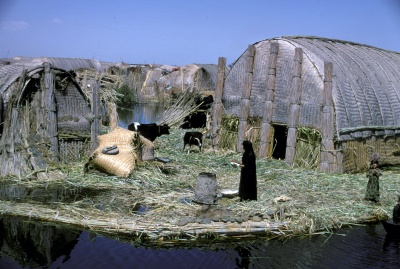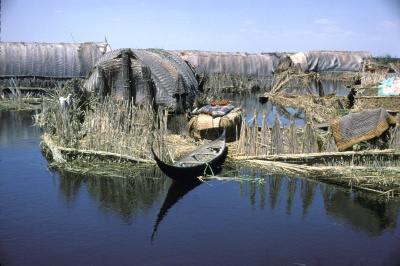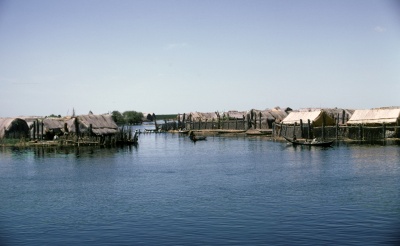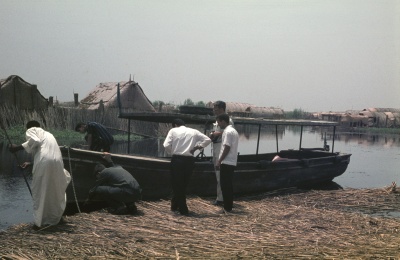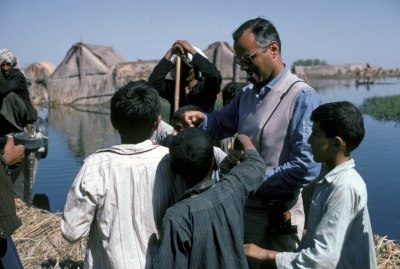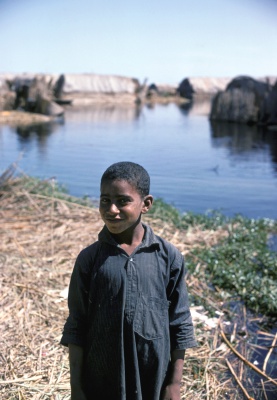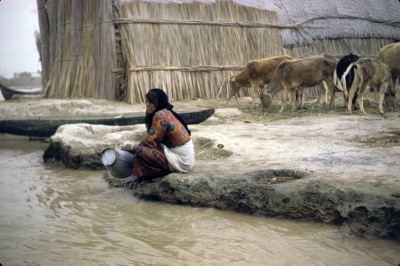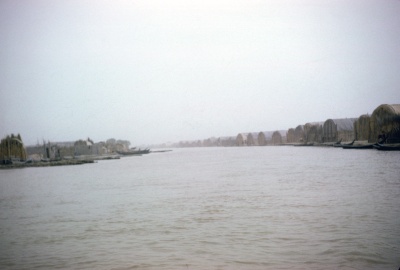3.3.1 Trip to Basra
In April 1969 I made a trip by car from Baghdad to Basra and back, with my brother Rien, who visited me in April 1969.
We first took the east road via Kut, Amara and Qurna this road was already paved in the 1960s. We visited the Marshes from Majjer El Kabir, which trip is described under 3.3.2: Trip to the Marsh Arabs. Returning from Basrah we took the west road via Suq al Suyukh, Naseriya, Samawa, Diwaniya, and Baghdad. In the 1960s only the leg Diwaniya- Baghdad was already paved. From Basrah to Diwaniya the road was still a desert sand track. In Naseriya we visited the ziggurat of Ur and the other Sumerian ruins around it, which is described in the archeological sites under 2.3. The trip Baghdad – Basra one way is about 550 km.
Basra was created in 635 by Caliph Omar and became in the late 1550s the capital of the Turkish province of Basra. Today Basra is the main port of Iraq for all non oil commodities. Note that the oil from the South Iraqi field of Rumaitha is shipped via FAO located at the mouth of the Shatt Al Arab. The main commodities exported from Basra in the 1960s were dates, barley and hard-wheat. The Turkish influence is still strongly visible in the many old Turkish houses.
The date industry
Basra is the centre of the Iraqi date industry. Based on survey data from the early 1960s there are in Basra Province about 10 million data trees, covering an area of some 100 000 ha of date trees.(Plant stand 9 /10 m by 9/10 m = 100 trees per ha )
Optimal conditions for date cultivation-Phoenix Dactylifera include a hot and dry climate, with a high water table. A local saying states that “The date tree likes to stand in the hot sun but have its feet wet” These conditions are available in Basra. The climate is hot and dry with temperatures up to 50 C in the shade during the period April-September. To irrigate the date gardens and for local transport thousands of kilometers of canal have been constructed, all connected to the Shatt Al Arab. The Shatt al Arab is a tidal river that means there is every day high and low tide as the sea is closely. This daily movement of water caused by to the differences between high and low tide, provides a natural circulation in the date gardens irrigation system in the Basra province. The Shatt al Arab water in Basra is however still sweet. Most of the Basra dates are exported. The main volume of the dates, mainly the lower qualities is exported to Pakistan and India, while the higher quality dates are exported all over the world, in particular to Europe and the USA.
The images of the road shown were all taken along the section Basra- Diwaniya. Pictures include samples of the empty desert landscape; an encounter with a friendly Bedouin, who invited us in his tent for coffee in the true Arab style; a waterwheel to be pulled by donkeys for irrigation; and some irrigation ditches.
In Basra we made a trip by a launch and made following pictures:
Sailing boats in the canals, used to ship dates and grains from the date gardens to Basra and beyond to other ports around the Arabian Gulf, in the South. Other images show the beautiful data gardens and the canals.
In Basra town we walked through the market streets admiring the many old Turkish houses.
3.3.2 Visit to the Marsh Arabs
THE MARSH ARABS OF IRAQ
A pictorial account of my travels to the Marsh Arabs
Living in South Iraq in the delta of the Euphrates and the Tigris
April 1967, April 1968 and April 1969
INTRODUCTION
Each year in April, I made a trip with my friend Saadoon to his home town Salam, during my stay in Iraq from November 1966 to November 1969. Salaam is a village located in the Central Marshes of South Iraq. We went by car from Baghdad to Majjer al Kabir, 30 km south of Amara, about 300 km south of Baghdad.
During the 1960s there were only a few foreigners residing in Iraq, mainly United Nations Development Program- and Embassy-staff members, as during that period, tourists and businessmen were not admitted to visit Iraq. Each foreigner, resident in the 1960s in Iraq, who planned to visit the Marsh Arab area in South Iraq, needed two permits: One general permit for traveling outside Baghdad, which was given by the central security service, of which the staff was Sunni. However, a second permit was needed to enter the actual area of the Marshes. This second permit could only be obtained from the local authorities responsible for the Marshes. These local authorities were Shiite and already in those days there was animosity between the Shiite from the Marshes and the Sunni from the Central Government. The result of this was that any person carrying a document of the Central Iraqi Government was therefore suspicious in the eyes of the local Shiite authorities and was seldom granted a permit by to visit the Marshes. Fortunately, in my case, one of Saadoon’s uncles in Majjer al Kabir, the border town at the edges of the Marshes, was responsible for issuing these permits and issued me and my guests each time a permit. In addition, Saadoons’ uncle each trip sent us a solder to accompany us as an armed escort.
After our arrival in Majjer al Kabir we first visited Saadoon’s uncle to pay our respects and ask for the permit. After this we hired a motor launch to travel to Salam, a trip of about three hours, an estimated distance of 35-40 km from Majjer al Kabir.
The Marshes in South Iraq
The marshes in South Iraq were located in the delta formed by the Euphrates and the Tigris rivers. This marshy delta covered in the 1960s an area of about 15000 square kilometers or approximately half the size of the Netherlands. Most of the central parts of the Marshes were permanently under water, while large strips of land at the edges of the Marshes were only flooded during springtime when the Tigris and Euphrates are overflowing with water from the snow melting in the Turkish mountains.
Within the marshes one traveled by flat bottom boat, using the natural canals through the reed fields. Each family owned at least one mushhuf or small canoe while rich families also owned a tarada- or large canoe. Mushhufs measured about 2.5 m long by 60 cm wide, while taradas may have had a length of up to 15 meters and a width of 90 cm. Both types of boats had flat bottoms. Taradas and mushhufs were constructed with planks from Iraqi mulberry wood and beams of imported hardwood from Malaysia or Indonesia. The simple tools needed for construction a sarida or tarada included saws, drills and knives for cutting curves. The boats were made waterproof with a layer of bitumen imported from Hit or Ramada in Central Iraq. Each year the bitumen layer had to be replaced cvs333& 334.
Mushhufs and taradas have been used for transportation within the Marshes since the days of Sumeria, 5000 -6000 years ago. Some baked clay seals, dating from that period already depict similar type of boats, while several miniature mushhufs and tirades made from silver were found in Sumerian king graves, dating from the third millennia BC.
In the 1960s, people also used larger types of boats: barges, called ballem and motor launches. These larger boats were used both to transport people and ship cattle, grain and reed mats from the marshes to the markets in Amara, Qurna and Basra. These boats because of their draught could only use the main marsh canals. cvs341
The Madan or Marsh Arabs
The marshes were in the 1960s inhabited by the Madan or Marsh Arabs, who were strict Shiite Muslims, followers of Hassan and Hussein. The Madan claimed that their forefathers were Bedouins, who recently settled in the marshes to escape the central Sunni authorities. However, when we compare their facial features with those of Sumerian statues, we notice that many of them have the typical round face with deep laying eyes and short mops nose of the old Sumerians. Their facial features differ much from the Bedouin Arab who has a long shaped face and a long sharp pointed nose. The facial features of my friend Saadoon and that of his family form a good example of Sumerian facial characteristics cvs326. Though Saadoon assured me that his forefathers were Arab Bedouins he may have more Sumerian blood in his veins than he is prepared to acknowledge.
Furthermore if we study the Sumerian sources of 3000 BC we find that the physical conditions in the area in those days were very similar to those of the 1960s. Already during the Sumerian period there were extended marshes in South Iraq, with huge fields of bulrushes- qasab, sedges-Phragmites,Tytha angostura, Scirpus brachyeras and other reeds.cvs336 & 337. From the Sumerian times till recently people living in the Marshes made similar types of flat bottom boats-tarada-cvs 332, 334 and mushhuf- cvs 338 and constructed similar types of reed houses: saridas and mudhifs. Images of the Sumerian period already show water buffaloes cvs355 and catching fish with the five pronged spears- cvs340, exactly as during the 1960s. Many of today’s Madan are probably direct descendants of the Sumerians of 5000 years ago. The population of the Marshes in the 1960s was estimated at about 400 000 persons.
The reed buildings
The reed buildings, used by the Madan, consisted of two 2 types: the sarida- cvs 328 used as family quarter and the more elaborate and larger mudhif, which served as guestroom-cvs 329& 330. Some of the mudhifs of the sheiks were huge constructions, measuring a length of up to 25 meters, with a width of eight meters wide and a height of three meters.
Construction of a mudhif or sarida was simple: One first made pillars from tidily bundled qasab reeds. These reed pillars were used as the frame for the reed house- cvs 335. This frame was subsequently closed with mats from qasab reed. If the reed house was located at the edge of the marshes, the reed pillars were directly planted in the firm soil. In the case of houses located in the middle of the permanent marshes, the Madan first make an artificial island. This was done by placing sedge pillars directly in a location with shallow water. Subsequently the Madan filled the area within the sedge pillars with mud and cut sedges till this artificial island emerged about 30-40 cm above the water level. Hereafter the reed house was constructed in the same way as at the edges of the marshes.
Food in the marshes
Food in the marshes was simple. Meals started with a glass of fermented buffalo milk, a sour drink similar to yogurt. The main dish was masgouf- grilled river carp. After being caught the fish was split in two halves, cleaned, salted and spit on a reed splinter. The reed splinter was then put near a dung fire for grilling. cvs 352, 353, & 354. Masgouf had a very delicate soft taste. Sometimes grilled chicken was served, which was prepared in the same method. The fish or chicken with the yogurt were served together with gubus, pieces of unleavened bread made from rice flour cvs 356. The rice, a type of floating rice, was grown at the edges of the Marshes, during the spring period when the area gradually was flooded. For details of baking the gubus in the gubus oven see cvs 052, 053 &054 of my Iraq agricultural series.
The water buffaloes.
The water buffaloes, a semi domesticated animal, formed the basis of the Madan economy. The buffalo provided milk and dung, but were seldom slaughtered for their meat. The milk was made into butter –ghee and yogurt, while the dung was dried into cakes and used for fuel to cook the food. Water buffaloes needed enormous quantities green reed cuttings called hashish. The buffalo owners therefore every day went to the reed field to cut hashish for their buffalo, while the buffaloes were also allowed during the day to roam freely on their own in the reed fields for grazing. In the evening the buffaloes returned on their own to the house of their owner.
Sand storms
As in other parts of Iraq, the marshes suffered often from sand storms, especially during spring time in March-April- May. On my last trip we encountered a sand storm on our return to Majjer Al Kabir. The usual blue sky rapidly turned milky yellow and a strong wind started to blow, covering us all with a thin layer of fine sand.
Concluding remarks:
My visits to marshes were an exiting experience which allowed me to study a traditional society, of which customs and physical conditions have probably not much changed since the Sumerian period, 5000 years ago. I am therefore grateful to my friend Saadoon, who made this possible.
Since the early 1950s only a few foreigners have been visiting the Marshes in Iraq. The famous traveler Wilfred Thesinger visited the Marshes during the 1950s. Another well know traveler was Gavin Young who visited the Marshes during the 1970s. Both wrote travel books about their experiences. Apart from these publications there are a few articles about the Marshes in the National Geographic Journal.
Addendum: March 2005 The situation in the Iraqi Marshes since the 1990s.
Recently I read that in the early 1990s Saddam Hussein drained most of the marshes by constructing dams in the Tigris and Euphrates above streams of the marshes. The dams allowed irrigating large tracts of land for mechanized grain production to feed the Iraqi population after imports had been reduced as an effect of the Gulf war in 1991. Due to the situation the majority of the Madan population, was forced to flee to Iran, where today they suffer in refugee camps. It is also argued that Saddam Hussein drained the marshes with the aim to control the Madan Arabs, who as long as they lived in the marshes had been inaccessible to his army. By draining the area Saddam Hussein could finally destroy the Madan and push them out of the country, in particular after the 1992 revolt of the Madan against Saddam Hussein’s regime.
The article also mentioned that at present it is studied how the water can be again diverted back to the former Marsh area and how the original flora and fauna could be restored.
Bogor, March 2005, October 2007.
Charles van Santen
References:
- Thesiger, Wilfred (1964) the Marsh Arabs. Longmans, London
- Young, Gavin (1977) Return to the Marshes, Collins, and London Photos Nik Wheeler
- Ochenschlager Eduard L.(2004)Iraq’sMarsh Arabs in the Garden of Eden, University of Pennsylvania Museum of Archeology and Anthropology, USA
- National Geographic Magazine:
1. February. 1958. Thesinger, Wilfred : Marsh Dwellers of Southen Iraq: Primitive Madan, building cathedral- like houses of reeds, and share a watery domain with buffaloes and wild Boars
2. April.1994 . Department of Geographica-No author: Iraq Imperils Marshes, a Way of Life. Article on the destruction of the Marshes by Saddam Hussein through drainage of the wetlands
